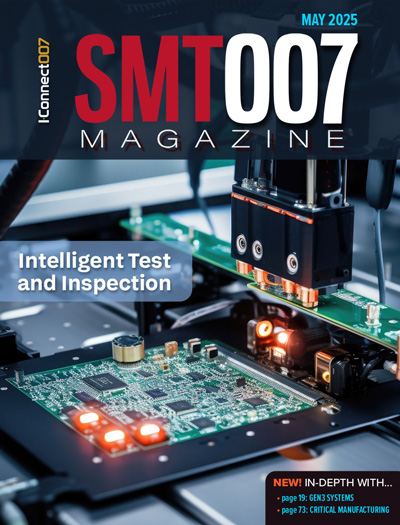-

-
News
News Highlights
- Books
Featured Books
- smt007 Magazine
Latest Issues
Current Issue
What's Your Sweet Spot?
Are you in a niche that’s growing or shrinking? Is it time to reassess and refocus? We spotlight companies thriving by redefining or reinforcing their niche. What are their insights?

Moving Forward With Confidence
In this issue, we focus on sales and quoting, workforce training, new IPC leadership in the U.S. and Canada, the effects of tariffs, CFX standards, and much more—all designed to provide perspective as you move through the cloud bank of today's shifting economic market.

Intelligent Test and Inspection
Are you ready to explore the cutting-edge advancements shaping the electronics manufacturing industry? The May 2025 issue of SMT007 Magazine is packed with insights, innovations, and expert perspectives that you won’t want to miss.
- Articles
- Columns
- Links
- Media kit
||| MENU - smt007 Magazine
Yield Enhancement Solutions with AOI
December 31, 1969 |Estimated reading time: 6 minutes
With the move toward finer pitches and smaller component sizes, reliable visual inspection for correct assembly has become increasingly difficult. As a result, implementation of automated optical inspection (AOI) has become widely accepted as a key process.
By Don S. Miller 
AOI offers early detection of defect trends and generates critical data required to make informed process decisions. Efficient use of the data generated by AOI systems to identify manufacturing problems can not only have a positive impact on product quality, but also can dramatically enhance product yields and reduce costs.
A variety of AOI systems on the market effectively detect manufacturing defects on a printed circuit board (PCB) production line. These systems can perform comprehensive PCB inspection for paste deposits, component presence, part nomenclature and reflowed solder joints at production line speeds (Figure 1). However, the technology and capability offered by these systems is promoted in such various ways that it may tend to confuse potential users at times.
Prevention vs. Detection
The two guiding philosophies for implementation of AOI are prevention and detection. Prevention places the priority on process control and elimination of defects by implementing corrective action. Detection, on the other hand, focuses inspection efforts on ensuring that no defective products escape from the factory floor.
 Figure 1. AOI display screen showing live video window, graphical representation of the board assembly with highlighted areas for inspection and parts lists.
Figure 1. AOI display screen showing live video window, graphical representation of the board assembly with highlighted areas for inspection and parts lists.
The first step in effectively implementing AOI requires a clear understanding of inspection philosophy and goals so that use of the equipment and data collection can be performed effectively. Different inspection goals dictate the need for different process control information and at varying levels of detail. Having a well understood set of goals helps ensure that the AOI system can be used to maximum benefit.
Inspection Goals
First Article Inspection. The use of AOI during first article inspection reflects the need to rapidly and effectively validate assembly setup prior to production runs. It is effective in confirming that all feeders are set up properly, nozzles have not worn out, and the placement machine is placing parts properly. The focus at this stage is inspection for part presence or absence, wrong part, or wrong orientation or polarity. This step is equally critical in higher-mix environments, where a variable part supply and setup errors tend to be the leading cause of defects, and in higher-volume environments where setup errors could have a significant negative impact on the production run.
Process Tracking. The AOI system is used with the goal of producing information to monitor the production process. Typically, this includes detailed defect classification and component placement offset information. Manufacturers tend to prioritize this inspection goal when product reliability is important and specific process problems are targeted in higher-volume/lower-mix environments.
Characterization. For inspection of high-reliability products where characterization often is the inspection goal, AOI is used to find all possible anomalies. The resulting inspection data reflects an almost nonexistent escape rate, but more false calls and a longer inspection time. Solder joint inspection can be an important criterion if the AOI system is used post-reflow.
Product Quality. Manufacturers focusing primarily on product quality are interested in the product's status at the end of the production process. Manufacturers typically prioritize this as an inspection goal when production issues are relatively well known and product mix is high. A wide range of general process data can be collected at this inspection stage because the AOI system is placed at the end of the line.
 Figure 2. Solder paste on pads.
Figure 2. Solder paste on pads.
First-pass Yield at ICT. Implementing AOI can improve yields at in-circuit test (ICT) by capturing and routing defective boards before ICT. The goal is to minimize the potential bottleneck that ICT creates with large production runs. Process control data available through implementing AOI at this stage is broader in scope because, as mentioned above, inspection generally is performed at the end of the line.
 Figure 3. Pre-reflow image. Note the dull gray paste covering the pads.
Figure 3. Pre-reflow image. Note the dull gray paste covering the pads.
The best location for AOI on the production line depends on equipment capability and what production problems must be solved. If the primary objective is to monitor the process and promote corrective action to prevent future defects, then pre-reflow inspection arguably is the best use of AOI. For pre-reflow inspection, the system can be placed right after paste printing, after the chipshooter, or after the fine-pitch placement machine (Figures 2 and 3).
 Figure 4. Post-reflow image taken with white light.
Figure 4. Post-reflow image taken with white light.
If the primary concern is detection and hence, quality of the end product, the best location is at the end of the line. For most production lines, this means post-reflow inspection. Although most, if not all, process defects are apparent and can be monitored at post-reflow inspection, use of the information may be drastically different than that collected in a pre-reflow location (Figures 4 and 5).
Equipment Selection
Once inspection philosophy and goals are determined, the equipment selection process requires a good understanding of AOI capabilities to meet these goals under various operating environments. Important considerations include system accuracy, repeatability, speed, false fails and false accepts, ease of setup, and CAD compatibility.
 Figure 5. Post-reflow image taken with solder light. Note the dark areas covering the pads, indicating a reflowed solder joint.
Figure 5. Post-reflow image taken with solder light. Note the dark areas covering the pads, indicating a reflowed solder joint.
Other key equipment selection criteria include reporting and repair tools, the important link between inspection, repair, yield enhancement, and cost reduction. After all, the true benefit realized from implementation of AOI comes from its ability to rapidly identify and report the location and nature of faults, thus providing the operator with data required for effective process control and/or repair.
Real-time data transmission and statistical process control (SPC) software monitors defect trends, and automated alarms help improve early warning capability, pointing manufacturing personnel toward the source of process excursions (Figure 6). Integrated repair solutions also are available in various configurations for either in-line or off-line use, and pinpoint the exact defect location. Color images also help operators verify defects to be analyzed and repaired.
 Figure 6. SPC software monitors defect trends to help provide an early warning to process deviations.
Figure 6. SPC software monitors defect trends to help provide an early warning to process deviations.
Recent discussion has centered around a closed-loop arrangement between each machine in the process and the AOI system(s). In this arrangement, defects are detected with AOI and automatically traced to the contributing machine. Theoretically, the AOI system could be used for process control by changing the variables to correct defects (or trigger operators to do so) on a real-time basis.
Finally, equipment cost must be considered with any AOI selection. System prices vary from a little more than $30,000 for off-line units to more than $200,000 for high-end systems. Initial acquisition costs for AOI can be significant in any return on investment (ROI) calculation and certainly could determine whether AOI will be implemented in multiple locations on the line. In any case, recent advancements in commercially available technology are pushing the price-performance curve in a favorable direction for AOI users. Considering the speeds at which camera and computing options are changing, it is important not to overpay for yesterday's AOI solution.
Conclusion
Electronics manufacturers long have been driven to identify and control defects to improve quality and enhance yields. Implementation of AOI has proven to be a successful way to achieve these goals. By assessing AOI inspection goals and methods that best meet specific needs, manufacturers can realize measurable gains in both quality and overall yields while dramatically reducing costs.
Don Miller, president, may be contacted at YESTech Inc., 1221 Puerta Del Sol #500, San Clemente, CA 92673; (949) 361-2714; Fax (949) 361-2724; E-mail: Sales@yestechinc.com; Web site: http://www.yestechinc.com.


